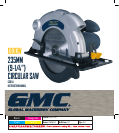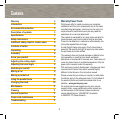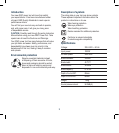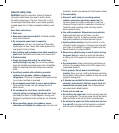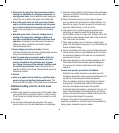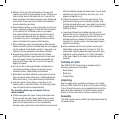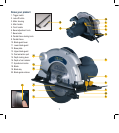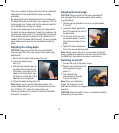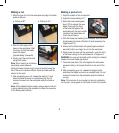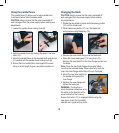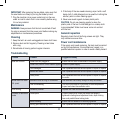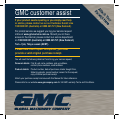
6
a. Maintain a firm grip with both hands on the saw and
position your arms to resist kickback forces. Position your
body to either side of the blade, but not in line with the
blade. Kickback could cause the saw to jump backwards,
but kickback forces can be controlled by the operator, if
proper precautions are taken.
b. When blade is binding, or when interrupting a cut for any
reason, release the trigger and hold the saw motionless
in the material until the blade comes to a complete
stop. Never attempt to remove the saw from the work
or pull the saw backward while the blade is in motion
or kickback may occur. Investigate and take corrective
actions to eliminate the cause of blade binding.
c. When restarting a saw in the workpiece, centre the saw
blade in the kerf and check that saw teeth are not engaged
into the material. If saw blade is binding, it may walk up or
kickback from the workpiece as the saw is restarted.
d. Support large panels to minimise the risk of blade
pinching and kickback. Large panels tend to sag under
their own weight. Supports must be placed under the
panel on both sides, near the line of cut and near the
edge of the panel.
e. Do not use dull or damaged blades. Unsharpened or
improperly set blades produce narrow kerf causing
excessive friction, blade binding and kickback.
f. Blade depth and bevel adjusting locking levers must be
tight and secure before making cut. If blade adjustment
shifts while cutting, it may cause binding and kickback.
g. Use extra caution when making a “plunge cut” into
existing walls or other blind areas. The protruding blade
may cut objects that can cause kickback.
The protruding blade may cut objects that can
cause kickback.
a. Check lower guard for proper closing before each use.
Do not operate the saw if lower guard does not move
freely and close instantly. Never clamp or tie the lower
guard into the open position. If saw is accidentally
dropped, lower guard may be bent. Raise the lower guard
with the retracting handle and make sure it moves freely
and does not touch the blade or any other part, in all
angles and depths of cut.
b. Check the operation of the lower guard spring. If the
guard and the spring are not operating properly, they
must be serviced before use. Lower guard may operate
sluggishly due to damaged parts, gummy deposits, or a
build-up of debris.
c. Lower guard should be retracted manually only for
special cuts such as “plunge cuts” and “compound cuts.”
Raise lower guard by retracting handle and as soon
as blade enters the material, the lower guard must be
released. For all other sawing, the lower guard should
operate automatically.
d. Always observe that the lower guard is covering the
blade before placing saw down on bench or floor. An
unprotected, coasting blade will cause the saw to walk
backwards, cutting whatever is in its path. Be aware
of the time it takes for the blade to stop after switch is
released.
Contents of carton
The GMC CS011A Circular Saw is supplied with the
following accessories as standard:
• Blade (fitted)
• Blade key
• Parallel fence
Unpacking
Due to modern mass production techniques, it is unlikely
that your GMC Power Tool is faulty or that a part is missing.
If you find anything wrong, do not operate the tool until the
parts have been replaced or the fault has been rectified.
Failure to do so could result in serious personal injury.
Assembly
The GMC circular saw is packed, fully assembled except for
the parallel fence.



